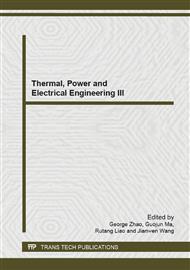[1]
R Pelrine, R Kornbluh, Q Pei and J Joseph. High-Speed Electrically Actuated Elastomers with Strain Greater Than 100% [J]. Science, 287: 836-839 (2000).
DOI: 10.1126/science.287.5454.836
Google Scholar
[2]
Y. Bar-Cohen, Electroactive polymer (EAP) actuator as artificial muscles, SPIE publication, Washington ( 2001).
Google Scholar
[3]
B Chu, X Zhou, K Ren, et al. A Dielectric Polymer with High Electric Energy Density and Fast Discharge Speed [J]. Science, 313(5785): 334-336 (2006).
DOI: 10.1126/science.1127798
Google Scholar
[4]
Pelrine, R., Kornbluh, R., Eckerle, J., Jeuck, P., Oh, S. J., Pei, Q. B., and Stanford, S., Dielectric elastomers: Generator mode fundamentals and applications, P Soc Photo-Opt Ins, 4329, 148-156 (2001).
DOI: 10.1117/12.432640
Google Scholar
[5]
Chiba, S. Waki, M., Masuda, K., and Ikoma, T., Current Status and Future Prospects of Electric Generators Using Electroactive Polymer Artificial Muscle, eds., Sydney, NSW, Australia (2010).
DOI: 10.1109/oceanssyd.2010.5603972
Google Scholar
[6]
Pelrine, R., Kornbluh, R., Eckerle, J., Jeuck, P., Oh, S., Pei, Q. and Stanford, S., Dielectric Elastomers: Generator Mode Fundamentals and Applications, Proc. SPIE 4329, pp.148-156 (2001).
DOI: 10.1117/12.432640
Google Scholar
[7]
Anderson, I. A., Mckay, T., O'brien, B., and Melhuish, C., Power for Robotic Artificial Muscles, IEEE/ASME Transactions on Mechatronics, 16(Compendex), pp.107-111(2011).
DOI: 10.1109/tmech.2010.2090894
Google Scholar
[8]
Kornbluh RD, Pelrine R, Prahlad H, et al., From boots to buoys: promises and challenges of dielectric elastomer energy harvesting. In: Electroactive polymer actuators and devices (EAPAD), Proc. SPIE 7976, 797605(2011).
DOI: 10.1117/12.882367
Google Scholar
[9]
Jean-Mistral, C., Basrour, S. and Chaillout, J. -J., Dielectric polymer: scavenging energy from human motion, Proc. SPIE 6927, 692716 (2008).
DOI: 10.1117/12.776879
Google Scholar
[10]
Koh, S. A., Zhao, X. H., Suo, Z. G., Maximal energy that can be converted by a dielectric elastomer generator, Appl. Phys. Lett. 94, 262902 (2009).
DOI: 10.1063/1.3167773
Google Scholar
[11]
McKay, T. G., O'Brien, B. M., Calius, E. P. and Anderson I. A., Self-Priming dielectric elastomer generator design", Proc. SPIE, 8340, 83401Y (2012).
DOI: 10.1117/12.915464
Google Scholar


